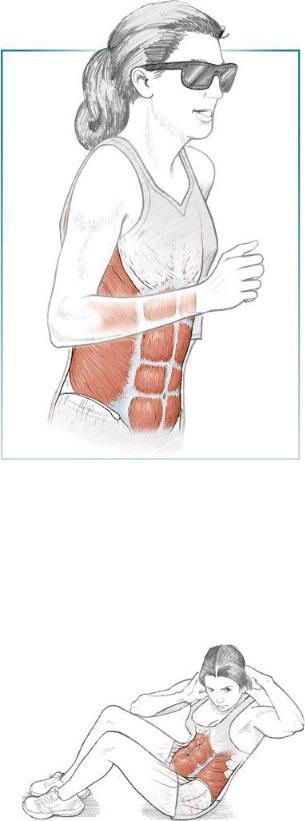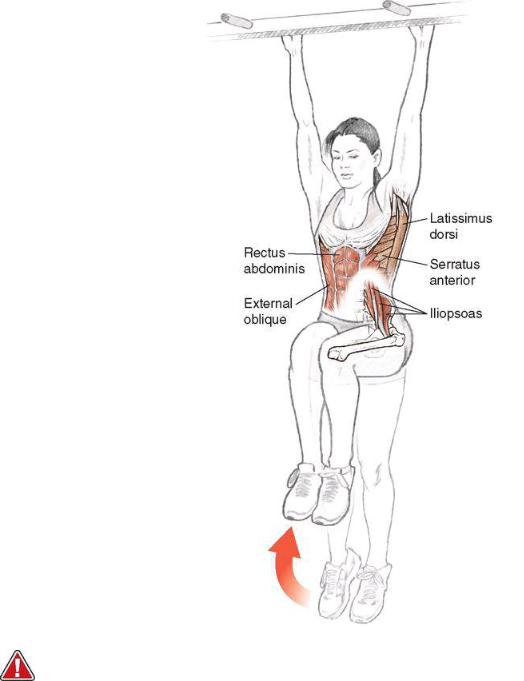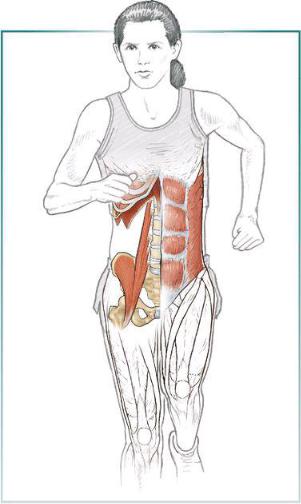
Анатомия бега (2010,иностр
.).pdfExecution
1.Lie on the back with knees steepled, feet pressed to the floor, and hands gently touching the back of the head, but not clasped.
2.Raise the torso by rounding the back one vertebra at a time while pressing the pelvis down to floor. Raise the torso only 45 degrees before lowering the back to the floor.
3.Inhale, and gradually lower the torso to the floor one vertebra at a time.

Muscles Involved
Primary: rectus abdominis, external oblique
Secondary: quadriceps, tensor fasciae latae
TECHNIQUE TIP
Sit-ups can be performed with a partner holding down the feet of the person performing the exercise. It makes the exercise easier, but allows more reps to be performed.
SAFETY TIP Don’t clasp, but gently touch the hands behind the head because it is easy to pull the head and torso up by using the muscles of the arms.

Running Focus
Because the quadriceps and hamstrings counterbalance each other, so do the muscles of the abdominals and lower back. To avoid muscle imbalances and potential injury, it is important to perform abdominal exercises after performing the strength-training exercises for the lower back described in the first part of this chapter. The sit-up should not be performed for speed, but in a relatively quick, fluid manner. The lowering of the torso should be done slowly, with attention to the work the abdominals are doing.
The rectus abdominis is the dominant muscle affected by sit-ups. It controls the flexion of the abdomen. Because almost all abdominal exercises work the rectus abdominis, a single set to failure can make up the start of an abdominal set.
The proper movement of the pelvis is critical to the gait cycle. A misalignment of the pelvis due to muscle imbalances between the abdominal muscles and the muscles of the lower back can cause injuries that impede running performance despite good cardiothoracic fitness.
VARIATION
Oblique Twist
A simple variation on the sit-up involves twisting the torso using the oblique muscles by attempting to touch the elbow to the opposite hip. A set of 12 can be done all on one side and then the other, or each rep can alternate sides.
ABDOMINALS AND PELVIS
Hanging Leg Raise

SAFETY TIP This exercise can put a lot of stress on the shoulder. Limit the number of reps if the shoulder is compromised.
Execution
1.Hang from a pull-up bar with palms facing forward. Emphasize lengthening, feeling gravity exerting its force on your spine.
2.Using a controlled movement, bring the knees up toward the chest. Keep the torso from swinging.
3.Gradually return to full extension and continue to repeat.
Muscles Involved
Primary: rectus abdominis, external oblique, iliopsoas
Secondary: latissimus dorsi, serratus anterior

Running Focus
The hip flexor muscles, specifically the iliopsoas, fatigue greatly during the course of a long run or race on a course that has the same terrain throughout. The repetitive nature of running is exacerbated with few terrain changes, and smaller muscles fatigue quickly. By strengthening the iliopsoas and the other hip flexors, runners can delay the onset of this fatigue. Also, when the terrain is hilly, requiring a lot of lifting throughout a run, weaker muscles will fatigue quicker, and gaining solid footing becomes harder.
VARIATION
Hanging Leg Raise With Twist
The standard hanging leg raise affects the external and internal oblique, but adding a twist to the side increases the role of these abdominal muscles that are responsible for rotation and lateral flexion of the torso. As was mentioned in the introduction to this chapter, the oblique muscles help to twist, allowing for terrain adjustments, and they aid respiration by working in conjunction with the diaphragm and ribs.

ABDOMINALS AND PELVIS
Dumbbell Side Bend
Execution
1.Stand with good posture, feet shoulder-width apart. Hold a dumbbell in one hand with the arm extended downward. The other hand is placed behind the head with the elbow out.
2.Bend at the waist in the direction of the hand holding the dumbbell, allowing the weight to pull the side down gradually.
3.Complete a set of 12 reps and then switch the dumbbell to the other hand and repeat.
Muscles Involved
Primary: external oblique
Secondary: rectus abdominis, quadratus lumborum
